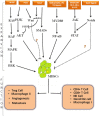The Yin and Yang of Myeloid Derived Suppressor Cells
- PMID: 30555467
- PMCID: PMC6280921
- DOI: 10.3389/fimmu.2018.02776
The Yin and Yang of Myeloid Derived Suppressor Cells
Abstract
In recent years, most of our knowledge about myeloid derived suppressor cells (MDSCs) has come from cancer studies, which depicts Yin side of MDSCs. In cancer, inherent immunosuppressive action of MDSCs favors tumor progression by inhibiting antitumor immune response. However, recently Yang side of MDSCs has also been worked out and suggests the role in maintenance of homeostasis during non-cancer situations like pregnancy, obesity, diabetes, and autoimmune disorders. Continued work in this area has armored the biological importance of these cells as master regulators of immune system and prompted scientists all over the world to look from a different perspective. Therefore, explicating Yin and Yang arms of MDSCs is obligatory to use it as a double edged sword in a much smarter way. This review is an attempt toward presenting a synergistic coalition of all the facts and controversies that exist in understanding MDSCs, bring them on the same platform and approach their "Yin and Yang" nature in a more comprehensive and coherent manner.
Keywords: epigenetics; homeostasis; immune regulation; immunosuppression; myeloid derived suppressor cells.
Figures


Similar articles
-
Myeloid-Derived Suppressor Cells: Not Only in Tumor Immunity.Front Immunol. 2019 May 15;10:1099. doi: 10.3389/fimmu.2019.01099. eCollection 2019. Front Immunol. 2019. PMID: 31156644 Free PMC article. Review.
-
Dual roles of myeloid-derived suppressor cells in various diseases: a review.Arch Pharm Res. 2024 Jul;47(7):597-616. doi: 10.1007/s12272-024-01504-2. Epub 2024 Jul 15. Arch Pharm Res. 2024. PMID: 39008186 Review.
-
Roles of the Exosomes Derived From Myeloid-Derived Suppressor Cells in Tumor Immunity and Cancer Progression.Front Immunol. 2022 Jan 27;13:817942. doi: 10.3389/fimmu.2022.817942. eCollection 2022. Front Immunol. 2022. PMID: 35154134 Free PMC article. Review.
-
Phenotypic and Functional Diversities of Myeloid-Derived Suppressor Cells in Autoimmune Diseases.Mediators Inflamm. 2018 Dec 23;2018:4316584. doi: 10.1155/2018/4316584. eCollection 2018. Mediators Inflamm. 2018. PMID: 30670926 Free PMC article. Review.
-
Expansion and functions of myeloid-derived suppressor cells in the tumor microenvironment.Cancer Lett. 2016 Sep 28;380(1):253-6. doi: 10.1016/j.canlet.2015.10.022. Epub 2015 Oct 28. Cancer Lett. 2016. PMID: 26519756 Free PMC article. Review.
Cited by
-
Targeting Myeloid-Derived Suppressor Cells in Cancer Immunotherapy.Cancers (Basel). 2020 Sep 15;12(9):2626. doi: 10.3390/cancers12092626. Cancers (Basel). 2020. PMID: 32942545 Free PMC article. Review.
-
The tumor microenvironment in renal cell cancer.Curr Opin Oncol. 2019 May;31(3):194-199. doi: 10.1097/CCO.0000000000000512. Curr Opin Oncol. 2019. PMID: 30985497 Free PMC article. Review.
-
The recent progress of myeloid-derived suppressor cell and its targeted therapies in cancers.MedComm (2020). 2023 Aug 2;4(4):e323. doi: 10.1002/mco2.323. eCollection 2023 Aug. MedComm (2020). 2023. PMID: 37547175 Free PMC article. Review.
-
The role of hypoxic microenvironment in autoimmune diseases.Front Immunol. 2024 Nov 7;15:1435306. doi: 10.3389/fimmu.2024.1435306. eCollection 2024. Front Immunol. 2024. PMID: 39575238 Free PMC article. Review.
-
Immune System Alterations in Multiple Myeloma: Molecular Mechanisms and Therapeutic Strategies to Reverse Immunosuppression.Cancers (Basel). 2021 Mar 17;13(6):1353. doi: 10.3390/cancers13061353. Cancers (Basel). 2021. PMID: 33802806 Free PMC article. Review.
References
-
- Han S, Yang Y. Phenotypic and functional dissection of myeloid-derived suppressor cells. Appl Biol Chem. (2016) 59:367–71. 10.1007/s13765-016-0172-9 - DOI
Publication types
MeSH terms
LinkOut - more resources
Full Text Sources
Medical

